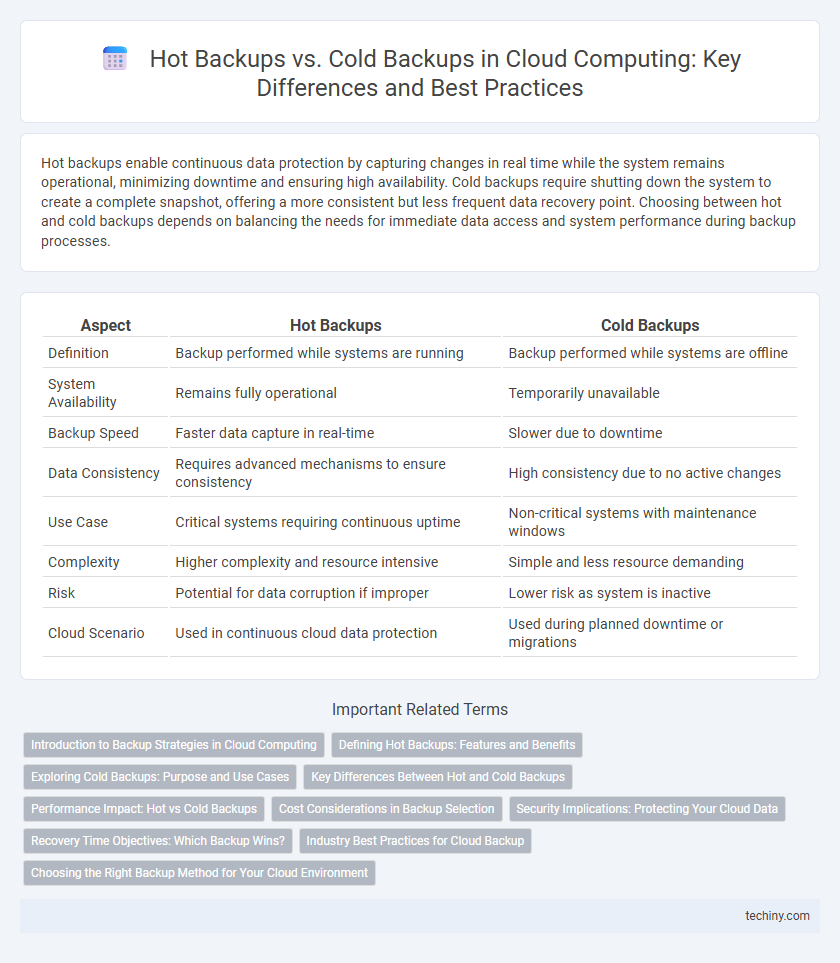Hot backups enable continuous data protection by capturing changes in real time while the system remains operational, minimizing downtime and ensuring high availability. Cold backups require shutting down the system to create a complete snapshot, offering a more consistent but less frequent data recovery point. Choosing between hot and cold backups depends on balancing the needs for immediate data access and system performance during backup processes.
Table of Comparison
| Aspect | Hot Backups | Cold Backups |
|---|---|---|
| Definition | Backup performed while systems are running | Backup performed while systems are offline |
| System Availability | Remains fully operational | Temporarily unavailable |
| Backup Speed | Faster data capture in real-time | Slower due to downtime |
| Data Consistency | Requires advanced mechanisms to ensure consistency | High consistency due to no active changes |
| Use Case | Critical systems requiring continuous uptime | Non-critical systems with maintenance windows |
| Complexity | Higher complexity and resource intensive | Simple and less resource demanding |
| Risk | Potential for data corruption if improper | Lower risk as system is inactive |
| Cloud Scenario | Used in continuous cloud data protection | Used during planned downtime or migrations |
Introduction to Backup Strategies in Cloud Computing
Hot backups in cloud computing enable data protection by capturing real-time snapshots without disrupting ongoing operations, ensuring continuous availability and minimal downtime. Cold backups involve pausing applications or systems to perform data copying, offering a consistent and stable backup state but requiring temporary service interruption. Effective cloud backup strategies balance these approaches to optimize recovery point objectives (RPO) and recovery time objectives (RTO) based on business requirements.
Defining Hot Backups: Features and Benefits
Hot backups involve creating data copies while the system remains operational, ensuring continuous access without downtime. Key features include real-time data synchronization, minimal performance impact, and support for transaction consistency. Benefits encompass improved data availability, reduced risk of data loss, and seamless disaster recovery in high-availability cloud environments.
Exploring Cold Backups: Purpose and Use Cases
Cold backups, which involve shutting down systems before data copying, ensure data integrity and consistency by preventing changes during the backup process. These backups are ideal for critical databases and applications that require zero data modification during backup, such as financial record systems or enterprise resource planning (ERP) platforms. Cold backups minimize the risk of corrupted backups, making them essential for disaster recovery plans where precise data restoration is paramount.
Key Differences Between Hot and Cold Backups
Hot backups enable data to be copied while systems remain fully operational, ensuring continuous availability and minimizing downtime. Cold backups require systems to be shut down or taken offline, resulting in complete data consistency but causing temporary service interruptions. Key differences include operational state during backup, recovery speed, and impact on system performance, with hot backups favoring minimal disruption and cold backups offering simpler consistency guarantees.
Performance Impact: Hot vs Cold Backups
Hot backups minimize system downtime by allowing data to be copied while applications remain operational, thus supporting continuous availability and reducing performance degradation during backup processes. Cold backups require halting all database operations to ensure data consistency, resulting in increased system downtime and noticeable performance impact. Organizations needing uninterrupted service often prefer hot backups despite the slight overhead, whereas cold backups are chosen for simpler implementation and absolute data integrity during idle periods.
Cost Considerations in Backup Selection
Hot backups incur higher costs due to continuous resource consumption and the need for robust infrastructure to maintain data availability during backup processes. Cold backups reduce operational expenses by pausing systems, requiring less computing power and storage bandwidth, but they may introduce downtime risks impacting business operations. Cost considerations in backup selection should balance infrastructure investment against potential revenue loss from system unavailability.
Security Implications: Protecting Your Cloud Data
Hot backups maintain continuous data availability during cloud operations, minimizing downtime but requiring robust encryption and access controls to prevent unauthorized access in real-time. Cold backups involve offline data storage, enhancing security by isolating backup copies from active systems and reducing exposure to cyber threats, though they may delay recovery times. Implementing multi-layered security protocols, including encryption, authentication, and regular integrity checks, is essential for safeguarding cloud data across both backup types.
Recovery Time Objectives: Which Backup Wins?
Hot backups enable continuous data protection with minimal downtime, significantly reducing Recovery Time Objectives (RTO) by allowing immediate system restoration without service interruption. Cold backups, while simpler and less resource-intensive, require complete system shutdown, extending RTO due to longer restore and restart processes. For mission-critical cloud environments demanding rapid recovery, hot backups clearly outperform cold backups in achieving optimal RTO performance.
Industry Best Practices for Cloud Backup
Hot backups in cloud computing involve creating backups of data while systems remain operational, ensuring minimal downtime and continuous availability, which aligns with industry best practices for disaster recovery and business continuity. Cold backups, performed when systems are offline, offer a simpler, lower-risk snapshot of data but increase downtime, making them less ideal for critical cloud environments requiring high availability. Industry leaders recommend leveraging hot backups in cloud infrastructures with automated snapshots, deduplication, and incremental backup strategies to optimize storage efficiency and recovery time objectives (RTO).
Choosing the Right Backup Method for Your Cloud Environment
Hot backups enable continuous data protection by capturing changes in real-time without downtime, ideal for cloud environments requiring high availability. Cold backups, performed during system shutdowns, offer complete data integrity but may disrupt cloud services. Selecting the appropriate backup method depends on recovery point objectives, system performance impact, and business continuity requirements within your cloud infrastructure.
Hot Backups vs Cold Backups Infographic

 techiny.com
techiny.com